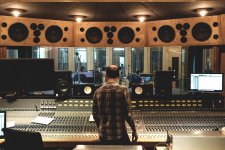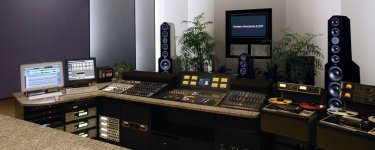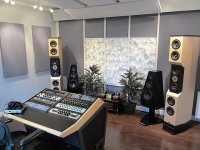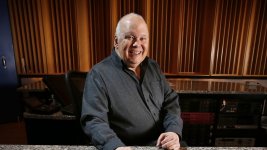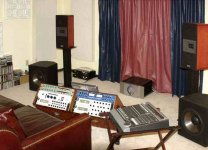Bruno is an exceedingly talented designer and I have not seen a negative review of the kii (vacu says he can do better, but I've not seen him say the Kii are junk). I just think you've never listened to decent speakers.
Not to forget that Geithain loudspeaker offered smart solutions wrt bass characteristics since decades:
Active loudspeaker
The Geithain are interesting. I assume the mid/treble mounting plate creates the slot to control bass directivity? But I think in the last few years things have jumped another step forwards. as DSP and a range of associated technologies are mature enough to be able to make things that were not feasible 15 years ago. The JBL M2 is almost the output of Toole's career in research and Bruno arguably has been developing the technologies behind the Kii since he was at university.
Cloth ears like me possibly can't tell tell them apart, but I do know what a well set up speaker with good clean source material can sound like. It costs to be able to get the 'vanishing room' sound stage tho, but hopefully there will be trickle down.
Cloth ears like me possibly can't tell tell them apart, but I do know what a well set up speaker with good clean source material can sound like. It costs to be able to get the 'vanishing room' sound stage tho, but hopefully there will be trickle down.
If you record and listen/playback in the near field, you all but eliminate the effects of the room and articulation, details etc are kept original as heard.
This is known in acoustic literature for many decades. I have measured and applied it for about 40+ years in my listening rooms. Most modern studios use near field monitoring... at least all the best ones. here is a recap of it for you guys who are very confused and don't know how to apply the science of acoustics and hearing to your home music systems. Acoustics: Critical Distance
Always listen with-in the critical distance. Near, at, and beyond the critical distance is dominated by the room sound.
http://www.aes.org/e-lib/browse.cfm?elib=1948
THx-RNMarsh
This is known in acoustic literature for many decades. I have measured and applied it for about 40+ years in my listening rooms. Most modern studios use near field monitoring... at least all the best ones. here is a recap of it for you guys who are very confused and don't know how to apply the science of acoustics and hearing to your home music systems. Acoustics: Critical Distance
Always listen with-in the critical distance. Near, at, and beyond the critical distance is dominated by the room sound.
http://www.aes.org/e-lib/browse.cfm?elib=1948
THx-RNMarsh
Last edited:
I find "details" are strange, overrated, and inaccurate generally speaking to the hobby as it is now. It's not that I don't hear a good amount of stuff, it's just that in real life you simply do not have them jumping out at you. Details are dominated by the much louder notes and such from instruments and voices. Most stereos that have a lot of detail are simply injected with RF so that it elongates the signal some so you can hear that stuff easier.
For me it's a better statement to more clearly be able to hear the difference in overall character for a studio, the sort of "lens" you are listening to. It could also be the equipment that was used for a live recording (like LSO-6006).
Furthermore instruments should have body to them. One reason I like to listen to my stereo in the other room is all the recordings environment characteristics are mostly deleted, and it can sound like someone's playing instruments in my house. Other times I enjoy the full experience and sit down in front of the stereo. Although in general I can say LP pops and clicks are better at a distance.
For me it's a better statement to more clearly be able to hear the difference in overall character for a studio, the sort of "lens" you are listening to. It could also be the equipment that was used for a live recording (like LSO-6006).
Furthermore instruments should have body to them. One reason I like to listen to my stereo in the other room is all the recordings environment characteristics are mostly deleted, and it can sound like someone's playing instruments in my house. Other times I enjoy the full experience and sit down in front of the stereo. Although in general I can say LP pops and clicks are better at a distance.
As ever Richard, your links pose more questions than they answer. As your link points out the critical distance has several variables, One of which is speaker directivity. You have changed from quads to M2s. This will have completely changed your critical distance. How did you change the listening position to account for this.
But also there is this point about recording vs mixing vs mastering. I have attached a couple of images of mastering suites and one of a very well known English recording studio. Mastering studios don't have NS-10s! So are you after the recording studio sound, or the mastering studio sound?
You will also notice that Bob Ludwig has put a LOT of effort into ensuring the reverberant field is correctly diffused! Would seem that 'listen nearfield' is an oversimplification unless I have missed something?
But also there is this point about recording vs mixing vs mastering. I have attached a couple of images of mastering suites and one of a very well known English recording studio. Mastering studios don't have NS-10s! So are you after the recording studio sound, or the mastering studio sound?
You will also notice that Bob Ludwig has put a LOT of effort into ensuring the reverberant field is correctly diffused! Would seem that 'listen nearfield' is an oversimplification unless I have missed something?
Attachments
As ever Richard, your links pose more questions than they answer. As your link points out the critical distance has several variables, One of which is speaker directivity. You have changed from quads to M2s. This will have completely changed your critical distance. How did you change the listening position to account for this.
But also there is this point about recording vs mixing vs mastering. I have attached a couple of images of mastering suites and one of a very well known English recording studio. Mastering studios don't have NS-10s! So are you after the recording studio sound, or the mastering studio sound?
You will also notice that Bob Ludwig has put a LOT of effort into ensuring the reverberant field is correctly diffused! Would seem that 'listen nearfield' is an oversimplification unless I have missed something?
First point. There is a LOT written about the application of the critical distance USE. I WILL ONLY INTRODUCE YOU TO IT. YOU CAN READ UP AND STUDY AND EVEN DO YOUR OWN MEASUREMENTS IN YOUR LISTENING ROOM TO DETERMINE YOUR CRIT DISTANCE.
The quads have a somewhat figure of 8 polar pattern with nulls to each side. No output to sides just front and rear. [The newer Quads have better power response than the early Quads]. Magnapan and other esl have similar polar patterns. This radiation pattern is useful if your speakers are near a side wall. It is not unlike the M2 in its' limiting horizontal dispersion. Both reduce or prevent reflections from the sides into the room. A more narrow dispersion/polar pattern will project into the room further before wall reflections and thus pushes the critical distance further away also.
The first picture is a studio done right.... there are 2 near field monitors to use situated close and between the engineer. The second and third one is done wrong on several counts.... the speakers are behind the console and thus some direct sounds are reflected off the back of the console. And the multiple driver speakers are too close to become point sources.
The last picture tells me nothing about the studio or anything else.
THx-Richard
Last edited:
But how did yours change with the swap? I'm interested how you changed your listening setup going between the two.
The second picture is Bob Ludwig's mastering suite. A lot of good records have been mastered in there!
Doesn't matter... would you listen with speakers behind desk blocking direct sound. I hope not.
Most people don't do it in mixing nor mastering. Though mixing would be a worse problem than touch-up and fine tuning/mastering.
When full freq range and wide dynamic range speakers are used... the large system is placed above the console and aimed down so that you still get a direct, near field shot at the sound... and mounted flush with the wall. This is best standard practice.
Such as ---
![SF_05_14_02[1].jpg SF_05_14_02[1].jpg](https://www.diyaudio.com/community/data/attachments/564/564439-c965b3a6a451f15a8f328c81ac99324f.jpg)
Bob Katz is better for recording and mastering. he hears the recording more accurately as recording producer heard it with near field and isnt blocked sound.
![DSC_0702[1].jpg DSC_0702[1].jpg](https://www.diyaudio.com/community/data/attachments/564/564530-30cce0e10b3f845d1116b0d1f0248c96.jpg)
But mastering isn't recording a band or musician. . Bob Katz: Mastering Audio |
THx-RNMarsh
Last edited:
When I visited Bob Katz many years ago he didn't have anywhere near that much stuff in his mastering room.
There is an IEC standard for a listening room that has a lot of really good recommendations in it.
The mastering facilities I have been to have not been perfect listening spaces. They are good but compromised to accommodate the controls etc. needed. But more important the mastering engineer has developed the skills and experience to know what to expect even with his flawed space/equipment. Change a speaker, even for a much better one and he/she will need time to adjust for the change. If the master was only good when played on a system that matched the mastering system it would not be much use elsewhere (and a commercial failure). The master needs to sound good on whatever it's played on.
There is an IEC standard for a listening room that has a lot of really good recommendations in it.
The mastering facilities I have been to have not been perfect listening spaces. They are good but compromised to accommodate the controls etc. needed. But more important the mastering engineer has developed the skills and experience to know what to expect even with his flawed space/equipment. Change a speaker, even for a much better one and he/she will need time to adjust for the change. If the master was only good when played on a system that matched the mastering system it would not be much use elsewhere (and a commercial failure). The master needs to sound good on whatever it's played on.
Mastering is not relevant ----- The process after recordings are made and mixing is done-- it then goes to be "Mastered" for commercial use... prep for CD or LP making. They adjust and normalize the song-to- song levels, clean up obvious noises and the like. They may even add a little compression. Sweeten it up some if a bad choice was made for a microphone. But over-all they don't mess with the mix or the sound. They clean it up and normalize it ready for commercial use. They make the Master.
The recording and mixing is what you want to hear as well as you can.... the basic sound tracks as musician and producer decided. They listen in near field in recording studios with near field monitors.....
You should listen in near field as well... and you can control that critical distance by doing a number of things --- controlled dispersion, point source speakers help too, room acoustic treatment and then listening/sitting in direct or near field.
Near field listening at the mixing console or in the home, minimizes the rooms' sound affecting the mix and if you listen as they did, you will have a much closer sound to which the people at the mixing console heard.... both without significant room contribution to what is heard.
THx-RNMarsh
The recording and mixing is what you want to hear as well as you can.... the basic sound tracks as musician and producer decided. They listen in near field in recording studios with near field monitors.....
You should listen in near field as well... and you can control that critical distance by doing a number of things --- controlled dispersion, point source speakers help too, room acoustic treatment and then listening/sitting in direct or near field.
Near field listening at the mixing console or in the home, minimizes the rooms' sound affecting the mix and if you listen as they did, you will have a much closer sound to which the people at the mixing console heard.... both without significant room contribution to what is heard.
THx-RNMarsh
Last edited:
Richard I am no expert on this, your narrative sounds logical. And I must admit that when I adapted my listening room with strategically placed absorbing panels, the sound got much better (I had too much reverb).
But it does mean that in almost all cases people will not hear what the recording is 'supposed' to sound like.
So we can worry and spend money to make our system sound 'lifelike' but without the factors you mention, it will not sound like the original.
Jan
But it does mean that in almost all cases people will not hear what the recording is 'supposed' to sound like.
So we can worry and spend money to make our system sound 'lifelike' but without the factors you mention, it will not sound like the original.
Jan
jan,
Yes, that's right. And, if changes to the room sound reflections and reverb made a big difference where you sit/listen, you weren't in the near field to begin with.... you were beyond the critical listening distance.... but it got you closer to the near field experience.
Note that with headphones, you are hearing only the near field sound... without your room reverb. Only the recorded reverb is there.... which is a good thing if it is there at all..... with close mic placement it must be artificially added or will sound flat and life less. But when natural hall reverb is picked up and you are in near field, you get an uncanny feeling of being transported to the hall where the recording performance was held. Very realistic (or in my terms -- accurate).
With a more directional speaker like the JBL M2, the critical listening distance is extended further from the speakers and allows a more practical listening distance in my living room and still have that near field detail in the sound experience.
THx-RNMarsh
Yes, that's right. And, if changes to the room sound reflections and reverb made a big difference where you sit/listen, you weren't in the near field to begin with.... you were beyond the critical listening distance.... but it got you closer to the near field experience.
Note that with headphones, you are hearing only the near field sound... without your room reverb. Only the recorded reverb is there.... which is a good thing if it is there at all..... with close mic placement it must be artificially added or will sound flat and life less. But when natural hall reverb is picked up and you are in near field, you get an uncanny feeling of being transported to the hall where the recording performance was held. Very realistic (or in my terms -- accurate).
With a more directional speaker like the JBL M2, the critical listening distance is extended further from the speakers and allows a more practical listening distance in my living room and still have that near field detail in the sound experience.
THx-RNMarsh
Last edited:
This is also claimed by the Kii - directional down to relatively low frequency (80Hz IIRC). It does mean it generally sounds 'different' when transplanted in the typical living room than whatever was there first. It will take some getting used to to appreciate the increased fidelity.
Jan
Jan
y
Standardizing on better mastering speakers like the JBL M2 helps a lot on both ends in several dimensions. And, you can still enjoy the music.
THx-RNMarsh
Mastering is not relevant
So which do you mean? I've asked several times?
Attached is one of Bob Katz mastering studios.
Attachments
It is becoming more common for mastering engineers to receive requests to work from stems. In such cases, they can set final mix balances, and even compress or EQ individual stems. As always, things keep evolving.
Also, one of the goals of mixing and mastering is to make recordings that will sound good on a variety of playback systems. To accomplish that, it means that mixes are not necessarily adjusted to sound their best on the mix playback system. For example, if mixing on NS-10s it might sound better to turn the bass way up which would usually be a mistake.
Mixes and masters that sound good on many different speakers are said to "translate." One of the more difficult things to learn about mixing can be how to produce mixes on one's own system that translate well to most other systems.
Also, one of the goals of mixing and mastering is to make recordings that will sound good on a variety of playback systems. To accomplish that, it means that mixes are not necessarily adjusted to sound their best on the mix playback system. For example, if mixing on NS-10s it might sound better to turn the bass way up which would usually be a mistake.
Mixes and masters that sound good on many different speakers are said to "translate." One of the more difficult things to learn about mixing can be how to produce mixes on one's own system that translate well to most other systems.
<snip>
You will also notice that Bob Ludwig has put a LOT of effort into ensuring the reverberant field is correctly diffused! Would seem that 'listen nearfield' is an oversimplification unless I have missed something?
Although it certainly is a "well behaving" room, i have a hard time to believe that the reverberat field is really diffuse.
See for example (and comparison) the tremendous effort that went into the famous Massenburg room at Blackbird studios:
https://www.blackbirdstudio.com/studio-c/
Nah blackbird has glass tops on the equipment racks 
Like their monitors! But this brings to my point. Should we be aiming for the acoustics of the mixing studio when the proper monitors are being used OR the mastering which should be what is signed off by the band?
Now I should note I am old school and use classical music as an arbiter of goodness in my personal system. And as such do not care if Mahler 9 sounds awful on a cheap system. sadly some labels do pander to lofi, luckily some, like Chandos, don't.
Like their monitors! But this brings to my point. Should we be aiming for the acoustics of the mixing studio when the proper monitors are being used OR the mastering which should be what is signed off by the band?
Now I should note I am old school and use classical music as an arbiter of goodness in my personal system. And as such do not care if Mahler 9 sounds awful on a cheap system. sadly some labels do pander to lofi, luckily some, like Chandos, don't.
The Geithain are interesting. I assume the mid/treble mounting plate creates the slot to control bass directivity?
Afair they used a quite ingenious flow resistance pattern so that bass cancelled out behind the speaker.
But I think in the last few years things have jumped another step forwards. as DSP and a range of associated technologies are mature enough to be able to make things that were not feasible 15 years ago. The JBL M2 is almost the output of Toole's career in research and Bruno arguably has been developing the technologies behind the Kii since he was at university.
Sure, but sometimes it´s just an old idea in new clothes or realized in a different way - not meant in a deprecative way, i am just often suprised what smart ideas were already around decades ago - another example would be the new B&O loudspeaker, a similar idea had somebody afair already at the time when D.E.L. Shorter wrote about the socalled (but never implemented
So which do you mean? I've asked several times?
Attached is one of Bob Katz mastering studios.
I have seen several systems B.K has used over time... here you show another close monitor near field setup.
I don't understand your question. ... which?
THx-RNMarsh
Last edited:
- Status
- Not open for further replies.
- Home
- Member Areas
- The Lounge
- John Curl's Blowtorch preamplifier part II
